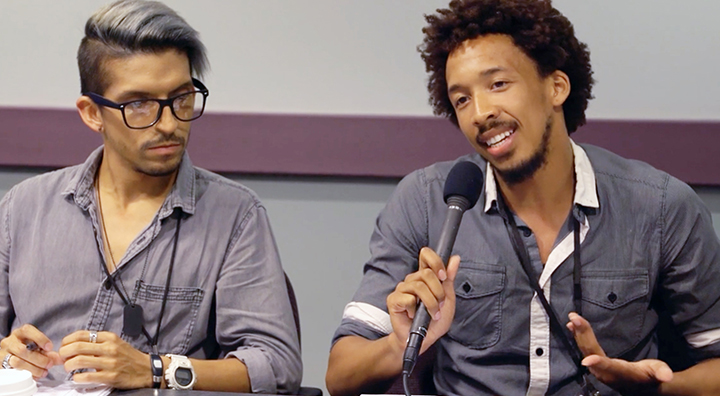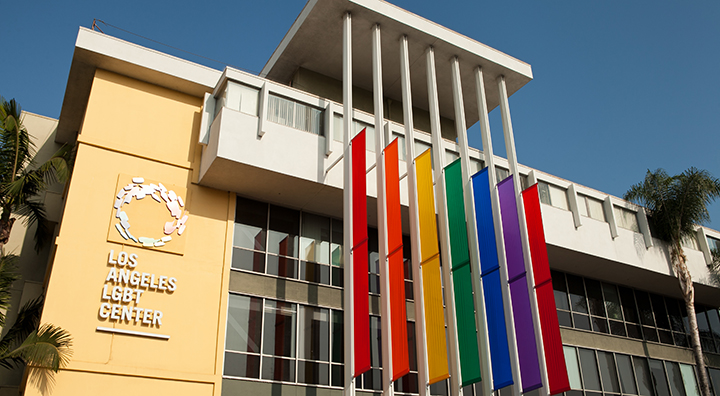HIV/AIDS Roundtable at L.A. LGBT Center

Entertainment is an effective way to inform viewers about important health and social issues, with TV and streaming shows such as Grey’s Anatomy, East Los High, Parenthood and 90210 credited with educating audiences about autism, breast cancer and domestic violence. Modern Family and Transparent have helped transform portrayals of LGBT characters and added to the cultural discussion of marriage equality and trans rights.
But despite all the progress that’s been made, one critical health-related topic in TV entertainment seems to have been eclipsed: HIV/AIDS depictions.
With that in mind, and drawing on its long-standing partnerships with the entertainment industry, CDC and local health agencies, Hollywood, Health & Society (HH&S) presented a roundtable titled HIV/AIDS in Entertainment that brought together TV writers, HIV experts, storytellers and members of the creative team from ABC’s hit series How to Get Away With Murder.
The discussion, held at the Los Angeles LGBT Center in Hollywood on National HIV Testing Day (June 27), couldn’t have been more timely in another way: A recent online story in Variety reported on the lack of HIV stories and characters on TV in 2016, and how the absence of educational messages from HIV representation in entertainment is possibly related to the steady rate of infection today.
How to Get Away With Murder (HTGAWM), executive produced by Shonda Rhimes and showrunner Peter Nowalk and starring Viola Davis, is a rare exception. The show’s two seasons included a storyline featuring the characters Connor Walsh and Oliver Hampton, a gay couple who undergo HIV testing. When Oliver discovers he’s HIV-positive, Connor begins a daily regimen of PrEP, or pre-exposure prophylaxis, an anti-HIV medication that keeps those who don’t have the virus from becoming infected.
The panel featured Erika Green Swafford, a co-executive producer for HTGAWM; Daniel Robinson, a researcher for the show; Francisco Ruiz, a team leader with the HIV/AIDS Prevention Division of the CDC; Brian Toynes, manager of the Sexual Health Education Program at the LGBT Center; Thomas Davis, a staff member at the LGBT Center and a co-chair for the C2P LA Coalition (Connect to Protect Los Angeles Coalition); and Gilbert Bazan, HIV case manager, medical care coordination, at Valley Community Healthcare. Kate Folb, director of HH&S, served as the moderator.
Panel members and guests were treated to a short clip of scenes from the Oliver-Connor storyline. Swafford described HTGAWM as a “very heightened environment”—after all, she said, people on the show are literally trying to get away with murder—that draws a sizable and loyal audience. But with the large viewership, Swafford said, also comes great responsibility in storytelling that’s set against a diverse cast of characters. In addition to showing people of color in positions of power, the TV drama’s creative team takes pains to ensure that storylines involving the lives of its characters from the LGBT community are as realistic as possible.
“We take a lot of time, especially with the help of HH&S, to make sure our storylines are correct. Our writers room reflects the importance of having people behind the scenes who are members of different and diverse groups—people of color, bisexual, gay, straight, white, black, Latino, Latino-Asian.”
—Erika Green Swafford
co-executive producer, How to Get Away With Murder (ABC)
“We take a lot of time, especially with the help of HH&S, to make sure our storylines are correct,” she said. “Our writers room reflects the importance of having people behind the scenes who are members of different and diverse groups—people of color, bisexual, gay, straight, white, black, Latino, Latino-Asian.”
As a matter of fact, Swafford pointed out, using PrEP in the ongoing HTGAWM storyline was an idea first raised by younger LGBT members of the writing staff.
Robinson said a lot of thought and discussion were given to the idea for the HIV and PrEP storyline, and that the information gathered during research helped the writers decide that it was a story worth telling because there was new information that needed to be shared with viewers.
“Pete [Nowalk] really wanted to get it right,” Robinson said. “We had lots of conversations with many different experts.”
Davis, 24, an LGBT activist who works in the sexual health education program at the center, and Bazan, 54, the case manager at the Valley Community health center, offered cross-generational accounts of their life experiences. Davis grew up in the small town of Estes Park, Colorado, the only “out gay kid in high school and one of the only students of color.” He had to drive an hour to meet anyone his age who was also gay.
“When I was younger, the only part of the gay world that I saw was through TV,” he said.
“I grew up in a very abstinent environment,” Davis said in a profile online for The Pride: Los Angeles’ LGBT Newspaper. “HIV was around but not talked about. So it was hard to be out and open.”

Moving to L.A. brought culture shock as he happily found himself suddenly among a thriving gay community. Davis enrolled in a performing arts school to study dance, made new friends and took advantage of gay dating apps such as Grindr and Jack’d. He was diagnosed as HIV positive a week before he turned 21. Looking back, Davis said his diagnosis didn’t change his life very much. He said the challenge for living with HIV basically came down to regular visits with a doctor to track his “viral load” (the amount of HIV in his blood), eating healthily, staying active and taking his prescribed medication.
Bazan came of age as a gay man in San Francisco and Chicago in the 1980s and early ‘90s, as the AIDS crisis took hold. Over the years he repeatedly tested negative for the HIV virus, until one day an illness brought with it fatigue and a rash. His full set of symptoms matched those listed in a roommate’s book on the disease, and so he sought out another test. This time, the results came back positive.
Bazan called those crisis years a “whole different world.” In the ‘80s, he said, the view of many in the gay community was that getting tested for HIV was pointless since no treatment existed. Why would you want to know?
“Everyone seemed to be dying of AIDS then,” he said. “I lost 25 friends, and sometimes it’s like living with survivor’s guilt.”
It’s a different experience today,” added Bazan, who told the roundtable that his clients have included a teen-age girl and high school seniors who have all tested positive.
Since 2010, Ruiz said the CDC has seen the rate of infection among young people in the U.S. increase, and that it was important for any messaging about HIV, whether on TV or in social media, to reflect their stories to raise awareness.
A disproportionate burden falls on the African American and Hispanic populations, Ruiz added.
“Nationally, we’re looking at 1.2 million people [overall] living with HIV,” he said. ”Of those, we estimate that about 1 in 8 don’t know they have it. There are 45,000 people being diagnosed ever year, so we’re not seeing a decline [in the rate of infection].”
Folb, who before joining HH&S consulted with the entertainment industry for many years on a number of health-related topics, recalled how depictions of HIV/AIDS on TV became the focus of her work in the ‘90s.
“The entertainment industry was hit very hard by the AIDS epidemic,” Folb said. “The loss of so many actors, writers and directors seemed to galvanize the industry to use their platforms to combat the disease.” Folb said HIV storylines on TV shows such as the long-running NBC medical drama ER, LIfe Goes On and The Bold and the Beautiful were able to quiet some of the panic by dispelling myths and educating millions of viewers about the disease.
But that was then. As the Variety story pointed out, the ongoing ER storyline about a straight African-American woman who finds out that she’s contracted HIV from her ex-husband aired more than 20 years ago. Outside of the HTGAWM storyline involving Connor and Oliver, there’s been precious few prominent examples of HIV-positive characters living real, full lives. In the early 1990s, The Real World featured Pedro Zamora, an HIV-positive actor and AIDS educator. In 2015, the HBO series Looking, about the gay male community in San Francisco, featured a character named Eddie (played by Daniel Franzese) who was HIV-positive and in a mixed-status relationship with another character who was HIV-negative. The ABC series Brothers and Sisters had an HIV-positive character in a storyline that ran from 2009-2011. Movies like HBO’s The Normal Heart by Larry Kramer and Tony Kushner’s Angels in America, based on their own plays, featured HIV-positive characters. But the storytelling, set against New York City in the near-distant past of the 1980s, plays more like chronicles from LGBT history.
In the Variety article, reporter Jim Halterman writes: “Shows like ABC’s Modern Family and Amazon’s Transparent were spending time exploring other issues that, while undeniably important, seemed to push HIV into the shadows. According to Franzese, as a community, ‘we’ve moved on to adoption and marriage equality and trans acceptance, but it seems that HIV has taken a backseat to those other movements and they are all important, but I feel like we need as a community to bring that issue back to the forefront.’ ”
What remains constant is the support and care of the Los Angeles LGBT Center, which since 1969 has provided HIV and STI testing and treatment, in addition to offering programs for housing, social services, culture and education. In 2015 the center saw more than 28,000 clients, diagnosing more than 4,000 cases of HIV and STD.
Following the roundtable discussion, participants were given the option to tour the LGBT Center and get tested for HIV.
This article was updated 09/30/16.



